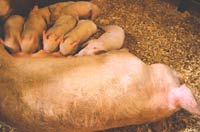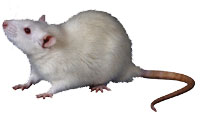Commendations for service veterinarians, induced molting among 2002 resolutions
|
Resolutions 4 and 5 seek commendations for veterinarians and veterinary technicians who have served the United States since the terrorist attacks on Sept. 11. Resolution 4 states: The American Veterinary Medical Association acknowledges and commends the outstanding achievements of active and reserve component veterinarians of the Uniformed Services of the United States of America who are supporting and participating in Operation Noble Eagle and Operation Enduring Freedom. The resolution was submitted by the following organizations: the District of Columbia VMA, the National Association of Federal Veterinarians, the American Association of Food Hygiene Veterinarians, the Delaware VMA, and the Pennsylvania VMA. Resolution 5 states: The AVMA acknowledges, recognizes, and commends the volunteer veterinarians and veterinary technicians who gave of their time, effort, courage, personal contributions, and financial support in the rescue and recovery efforts on and after September 11, 2001 following the terrorist attacks on the United States of America. The resolution was submitted by the New Jersey VMA, the Virginia VMA, the Delaware VMA, and the Pennsylvania VMA.
Induced molting The current AVMA guidelines state: The process designed to bring the entire flock into a nonlaying and oviduct rejuvenation period (commonly called induced molting) is a management practice that should be done under careful supervision and control. The once-practiced long-term total feed and water withdrawal that resulted in high levels of mortality is not acceptable. Under no circumstances should water be withheld. A carefully monitored and controlled program that may include reduced photoperiod [day length], controlled calorie intake through dietary restriction, and/or reduction in some nutrients essential to egg production [i.e., sodium] is acceptable. Feed restriction should be minimized. Careful monitoring of bird weights and weight loss, mortality, egg production, and behavior are needed to ensure that proper results are achieved humanely. Feather loss [molting] is not a reliable index of the progress and success of a resting and rejuvenation program. The goal is to improve the bird's ability to produce a high-quality egg with a good shell, not to replace the feathers. Additional research is needed to improve the welfare aspects of the molting process. This year, delegates will have two alternative resolutions to consider. Resolution 6, submitted by the American Association of Avian Pathologists and the Association of Avian Veterinarians, promotes AVMA support of carefully managed induced molting practices. It calls for further research into ways to improve the method and recommends alternative diets instead of denying the birds food. The resolution states: Molting is a natural seasonal event in which birds substantially reduce their feed intake, cease egg production, and replace their plumage. Induced molting is a process that simulates the natural molting events. Induced molting extends the productive life of commercial chicken flocks, improves long-term flock health and performance, and results in substantial reduction in the number of chickens needed to produce the nation's egg supply. When birds return to full feed, a new plumage develops and the birds resume egg production at a higher rate with better egg quality. Induced molting also has a positive impact on the environment through reduction of waste and natural resources needed for growing more birds for egg production. The commercial induced molting procedure is carefully monitored and controlled. Acceptable practices include reduction of photoperiod and "day length" dietary restrictions that result in cessation of egg production, but water should not be withdrawn. Intermittent feeding or diets of low nutrient density are recommended rather than total feed withdrawal. Special attention should be paid to flock health, mortality, and bird weight. Egg quality and safety should be monitored through an egg quality assurance program. The welfare of the birds should be a major consideration in this and any management practice. The AVMA encourages ongoing research into the effect of various methods of induced molting on the performance and well being of laying chickens. Dr. Robert Eckroade, the CEO of the AAAP, said the resolution was a response to opposition to induced molting in previous resolutions initiated by the Association of Veterinarians for Animal Rights. "We're responding to an animal welfare issue and we're trying to advance current thinking and science," Dr. Eckroade said. "It's an attempt to be sensitive to animal welfare and still follow science-based decisions." Dr. Daryl Styles, a representative of the AAV, said his group believes the resolution will help to improve the overall health of poultry. "We feel it will improve avian welfare by improving the way poultry are raised," Dr. Styles said. "Both AAV and AAAP feel there is room for improvement in the way poultry are raised." Dr. Styles added that poultry producers are also open to improving their practices on the basis of scientific evidence. "We feel the producers are open to change as long as it can be shown to be beneficial to both the producer and their flocks," he said. But other groups oppose the practice of induced molting entirely. The Association of Veterinarians for Animal Rights has once again initiated a resolution opposing induced molting. Resolution 7, which was submitted by petition, opposed the practice of withholding food and water as inhumane and questions the effect of induced molting on the bird's health. The proposed resolution states: The AVMA recommends that all hens used in commercial egg production receive fresh water and nutritionally adequate food on a daily basis, unless a brief period of food withdrawal is required for therapeutic purposes. It opposes induced or forced molting, the process designed to bring an entire flock of hens into a non-laying and oviduct rejuvenation period at the same time, when it involves the withholding of water or food or employs some other means of causing a molt which results in malnutrition or other ill health or when it compromises well-being. "Since it involves starving birds for as much as two weeks—which is illegal in some states—it is definitely animal cruelty," said Dr. Holly Cheever, the AVAR board member who submitted the petition. Dr. Cheever said that AVAR members feel a statement from the AVMA condemning the practice of withholding food is long overdue. "This is something that really must be addressed very strongly by the AVMA," Dr. Cheever said.
Sow housing The current AVMA position states: Individual tethers and stalls for sows are acceptable when monitored, maintained, and adjusted by responsible personnel. The resolution states: The American Veterinary Medical Association supports the use of sow housing configurations that:
Current scientific literature indicates that individual gestation stalls meet each of the aforementioned criteria, provided the appropriate level of stockmanship is administered. Dr. David Madsen, who is certified by the American Board of Veterinary Practitioners in the Specialty of Swine Health Management and serves as the delegate for the American Association of Swine Veterinarians, said the resolution was a response to animal rights' groups objections to use of gestation stalls. "Sow housing has come under attack not only in the U.S.—particularly in Florida—but worldwide," Dr. Madsen said. In Florida, animal rights groups, have petitioned to add an amendment to the state constitution that would ban the use of individual gestation stalls, which the groups say are inhumane. Dr. Madsen said AASV felt the current AVMA position on sow housing did not adequately address the importance of good management and did not emphasize the scientific research backing the practice. "Proper [human management] of any practice is vital," he said, adding that a lot of research has been conducted on the practice. Dr. Madsen indicated that the AASV believes that, "The scientific community has examined sow gestation stalls and found them to be adequate."
Laboratory animal regulations The resolution further states: As a matter of principle, the AVMA will promote the veterinary expertise of its members and their right to exercise professional judgment in using that expertise to assure the appropriate care and treatment for animals under their charge. Dr. B. Taylor Bennett, the delegate representing ASLAP, said that changes in the Animal Welfare Act that expand the number of procedures designated as painful procedures, and proposed changes to the government's policy on psychologic stress in primates used in research, were the impetus for the resolution. "[The changes to the Animal Welfare Act] eliminate the veterinarian's ability to evaluate on a case by case basis if a procedure is painful," Dr. Bennett said. Dr. Bennett added that the proposed Department of Agriculture changes in the policy on primate psychologic health disregard recent studies on the subject. "The regulations must be based on sound science and current medical practice," he said. In general, Dr. Bennett said the resolution seeks to bolster the right of veterinarians to exercise their professional judgment. "We need to say we're the experts, turn to us," he said. Delegates' directory | ||||


